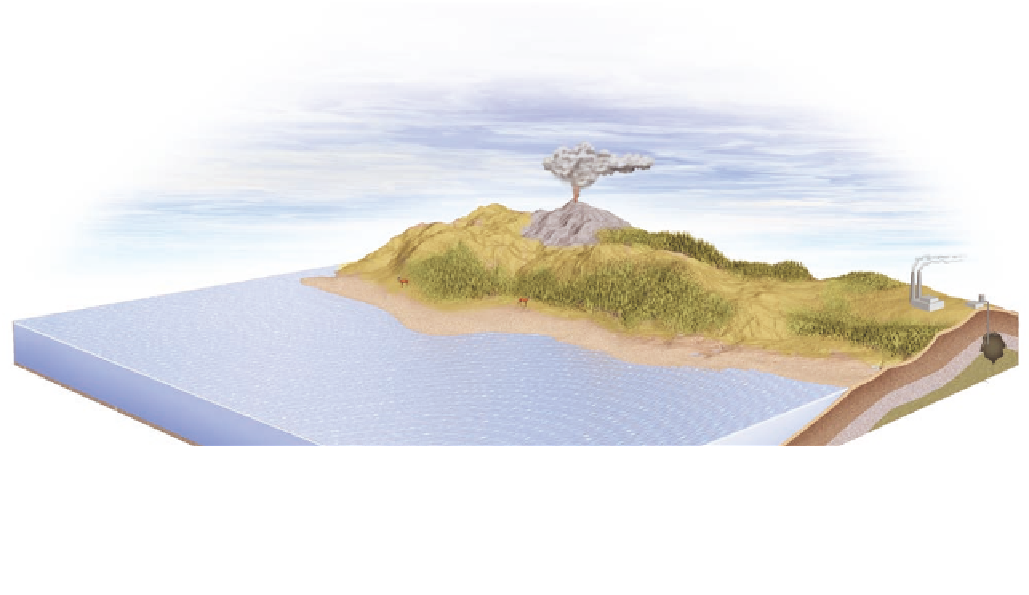Geoscience Reference
In-Depth Information
Figure 9.24 The carbon cycle.
The carbon cycle represents the flow of carbon that occurs on Earth as it moves from one
reservoir to another. Note the various places where carbon is stored and the amount of carbon contained within these reser-
voirs. (Reservoirs are noted in boldface type, transfers in italic type.)
The Carbon Cycle
In order to understand the science of the global warming is-
sue, it is first necessary to briefly review the carbon cycle and
the “greenhouse effect.” Recall from Chapter 4 that the various
components of the atmosphere, including the constant and vari-
able gases, were investigated. One of the variable gases is car-
bon dioxide, CO
2
. Although CO
2
comprises less than 1% of the
atmosphere, it is an important natural regulator of temperature
because it traps longwave radiation emitted by Earth, similar to
how a greenhouse functions.
Carbon is one of the essential elements of life and is a part
of all living things. It is stored in many different places on Earth
and, over time, moves from one
reservoir
to another. Figure 9.24
is an idealized diagram of how the carbon cycle works, with
storage and transfer amounts in billions of metric tons. A sim-
ple example of a transfer is the flow of carbon that occurs when
a blade of grass dies and decomposes. During its life, carbon
was stored within the grass fiber. After the blade of grass dies,
however, it decomposes and the carbon within it (among other
things, such as minerals) is gradually incorporated into the soil,
where it is stored for a period of time.
The carbon cycle progresses fairly rapidly, by geologic
standards of time, and can be measured in years to centuries.
Nevertheless, it is thought that less than 1% of the total amount
of Earth's carbon is actively within the cycle at any moment
in time. If you examine Figure 9.24 again, you can see, for
example, that about 120 billion metric tons of carbon transfer
back and forth between plants and the atmosphere every year.
(A metric ton is 1000 kg; multiply by 1.1 to get the equivalent
number of English tons, each of which is 2000 lb.) Although
this sounds like a large number, it is small when you con-
sider that 100 million billion metric tons of carbon are stored
in marine sediments and rocks, mostly as calcium carbonate
(CaCO
3
). These carbonates are largely the remains of dead or-
ganisms that accumulated on ocean bottoms millions of years
ago. Other large quantities of carbon are contained within coal
and petroleum deposits that essentially consist of decomposed
plant and animal matter.
Fossil fuels
are carbon-containing energy sources such
as coal, natural gas, and petroleum that are extracted from the
ground in mines and wells. The term
fossil fuels
comes from
the fact that these compounds were once living organisms that
died and slowly fossilized due to intense pressure and heat,
turning into other carbon compounds over thousands and mil-
lions of years. The vast majority of the energy required in this
industrial and technological age is derived from the consump-
tion of these fuel sources in one form or another. As you can
imagine, a tremendous amount of energy is required to power
the complex and interconnected web of factories, automobiles,
shopping malls, home appliances, and every other conceiv-
able modern convenience in the world today (Figure 9.25).
To put this thought in perspective, consider that 98,000 kg (98
tons/216,000 lb) of prehistoric plant material is required to pro-
duce 3.8 L (1 gal) of gasoline. Viewed another way, you need
Fossil fuels
Carbon-based energy sources, such as gasoline
and coal, that are derived from ancient organisms.






















